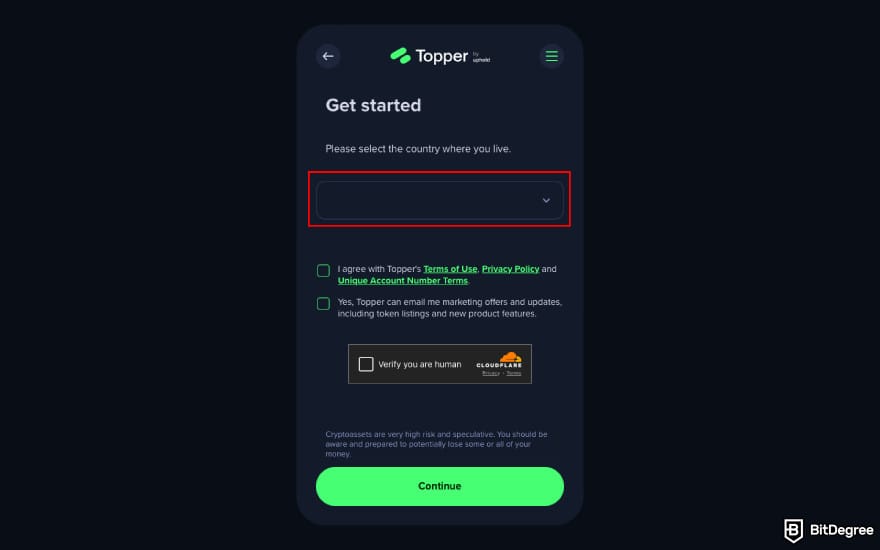
Stop overpaying - start transferring money with Ogvio. Sign up, invite friends & grab Rewards now! 🎁
Anyone looking to buy or sell crypto these days can have their pick of options: CEXs, DEXs, or even directly from their crypto wallets. But you’ll probably agree that this functionality isn’t most platforms’ strongest suit. In this Topper crypto review, I’ll introduce you to an alternative that promises to bridge fiat and crypto in a much more convenient way.
Launched in 2015 by Uphold, one of the most popular crypto exchanges, Topper is a fiat on-ramp service that lets users easily buy or sell crypto with fiat and send it to a non-custodial wallet or their credit/debit card.
If you’ve never encountered this type of solution before, it’s about time you dig into this review and discover what you’ve been missing out on! Is Topper crypto legit? How long would a Topper crypto order take? Learn all this and more, and get some hands-on experience with a comprehensive step-by-step tutorial.
Verdict at a Glance:
Topper is a convenient and user-friendly fiat on-ramp service that lets users buy crypto with fiat or sell their assets and withdraw funds to their credit or debit card. It supports 26 fiat currencies and is available in 150+ countries, but charges relatively high fees compared to most crypto exchanges.
Pros
- Two-way ramp functionality
- Large selection of payment methods
- Broad geographical availability
- Ledger Live integration
- Easy-to-use interface
Cons
- Relatively high fees
- Limited cryptocurrency support
- Few options for fund recovery
Table of Contents
- 1. Topper Crypto Review: A Quick Overview
- 2. Topper Alternatives
- 3. Who’s Topper For?
- 4. Advantages
- 5. Limitations
- 6. Crypto Buying & Selling Features
- 7. Fees & Limits
- 8. Security
- 9. Localization & Regional Adaptability
- 10. User Experience
- 11. How to Use Topper
- 12. Comparison to Other Popular Alternatives
- 12.1. Topper VS Binance
- 12.2. Topper VS Kraken
- 12.3. Topper VS Bybit
- 12.4. Topper VS Uphold
- 13. Conclusions: Is Topper Right for You?
Topper Crypto Review: A Quick Overview
Before we begin, here’s a quick snapshot of Topper’s key features and other basic information:
Type | Crypto-to-fiat on and off-ramp service |
Is Topper Safe? | Yes |
Established in | 2015 |
Headquarters | New York, US |
Availability | 150+ countries |
Licenses | FinCEN, OFAC, FCA, FINTRAC, FCIS |
KYC Verification | Yes (mandatory basic verification) |
Security | 2FA, KYC, encrypted payment & identity data handling, PCI-DSS compliance for card payments |
Features | Buying and selling crypto with fiat |
Supported Cryptocurrencies | BTC, ETH, USDT, SOL, + 241 more |
Supported Fiat Currencies | EUR, USD, GBP, + 23 more |
Deposit & Withdrawal Methods | Apple Pay, Google Pay, PayPal (US only), credit/debit card, SEPA, Pix (Brazil only) |
Fees |
|
Customer Support | Support ticket |
Privacy & Anonymity | – |
Table: Quick overview of Topper.
As you can see, Topper’s functionality is quite simple, and even though it’s owned by Uphold, it doesn’t share all of its features (its security measures look quite different, for example – you’ll find out why soon!).
Topper Alternatives
Topper isn’t your typical crypto trading platform - it comes with its own unique set of advantages, but if you’re not too familiar with crypto-to-fiat on/off ramps, you’ll probably want to use centralized exchanges as a benchmark for comparison. With that in mind, here are the best alternatives for Topper:
- Binance. With 280+ million users across more than 180 countries, Binance is one of the largest global exchanges. It supports 500+ cryptocurrencies and several types of trading with competitive fees.
- Kraken. Launched in 2011, this platform is one of the oldest CEXs. It has margin and futures trading and supports several fiat currencies for spot trading, among other features.
- Bybit. This platform features an intuitive interface and versatile trading options like margin, futures, and copy trading, as well as numerous staking and earning programs.
- Uphold. Launched in 2013, this exchange has more than 256 coins, a wide range of funding methods, and additional services like Uphold Card and Uphold Pay.
|
|
|
|
|
|---|---|---|---|
| Beginners | Advanced Users & Beginners | More Advanced Users | |
| United States, Germany, United Kingdom, France, Canada, + 190 more | Turkey, Argentina, Vietnam, Ukraine, + 180 more | South Korea, United Kingdom, Ukraine, Turkey, +160 more | |
| All Kraken Coupons | See All Coupons of Best Exchanges | See All Coupons of Best Exchanges | |
| One of the best crypto exchanges, especially in the US. | One of the leading crypto exchange platforms in the industry. | A popular crypto derivatives exchange with some super-low trading fees. | |
| Supported ✅ | Not Supported ❌ | Not Supported ❌ | |
| Visit site Read review | See TOP10 Brands Read review | See TOP10 Brands Read review |
Table: A brief comparison of Binance, Kraken, and Bybit
I’ll elaborate on how the platform in question fares against these household names in a separate section in this Topper crypto review – but for now, all you need to know is that Topper certainly has some stiff competition to live up to!

Did you know?
All Crypto Exchanges may look similar to you but they're NOT all the same!
Who’s Topper For?
As a prelude to answering the question, “What is Topper crypto?”, let's take a look at the types of users who might benefit the most from this platform, to give you a little hint on what (and who) it’s really for:
1
Crypto Newbies. If you’ve only just gotten into crypto and haven’t had the time to build up your portfolio yet, you’re going to have to buy some crypto with fiat first, and on-ramp services like Topper are one of the quickest and simplest gateways with no fuss attached.
2
Fiat-to-Crypto Traders. With the exception of a few popular CEXs, most crypto exchanges aren’t particularly fiat-friendly. Topper, on the other hand, offers a sizable fiat currency selection and plenty of fiat payment and transfer options.
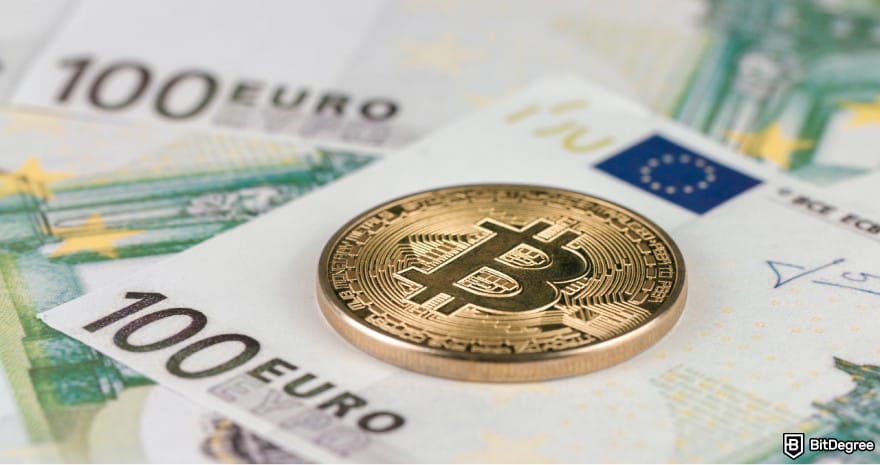
3
Fans of Online Crypto Payments. Topper has introduced a widget service for businesses, enabling them to allow customers to purchase some crypto with fiat (or the other way around) right on their website, which is an excellent time-saver for people who’d love to use their crypto as a payment method more often.
4
Non-Custodial Wallet Owners. Due to its nature, Topper doesn’t store your crypto in hot wallets; it can only transfer your assets to or from a non-custodial wallet, which makes it a convenient option for those who already prefer self-custody, such as DEX users and DeFi enthusiasts.
5
International Users. One of Topper’s major advantages is a broad global coverage in 150+ countries, making it perfect for residents of the US, Canada, and other countries that often get shafted by major crypto exchanges because of local regulations.
If you happen to fall into any of these categories, this Topper crypto review might just be what you need right now – so read on and find out what’s in it for you!
📚 Related: The Power of Crypto Self-Custody
Advantages
After giving this service a thorough trial run, here’s what I think makes it stand out from the crowd:
- Two-way ramp functionality;
- User-friendly interface;
- Large selection of payment methods;
- Broad geographical availability;
- Ledger Live integration.
While there’s a growing number of fiat-to-crypto on-ramp providers out there, few platforms offer an equivalent off-ramp functionality that lets users sell their crypto for fiat and transfer the funds to their credit or debit card. But if you visit Topper, “Buy Crypto” and “Sell Crypto” are both represented as options on its conversion panel, which definitely gives it an edge over many other competitors.
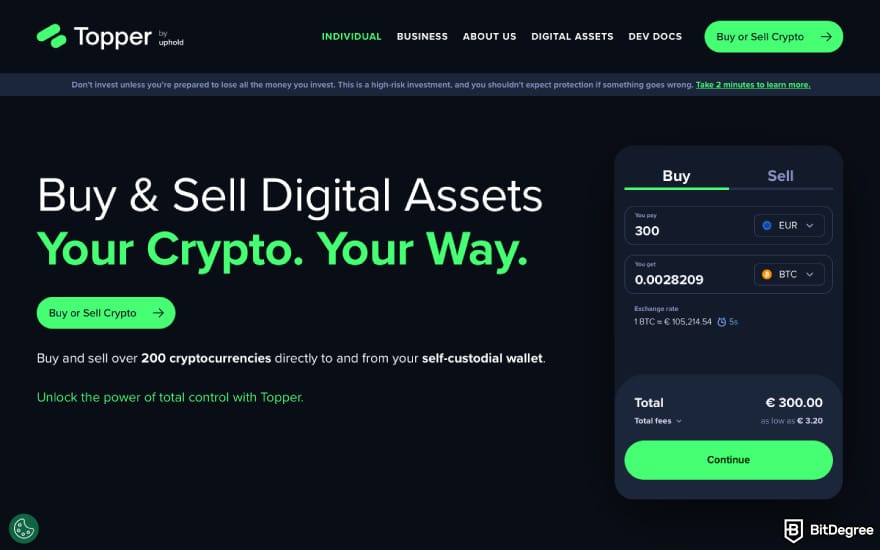
Topper’s simplicity is another major selling point. Unlike with centralized exchanges, you won’t have to deal with a complicated user interface or wade through all the bells and whistles just to get what you need.
Topper features a relatively minimalist panel, and the sign-up process and KYC verification are integrated into the buying or selling workflow, with the platform guiding you through every step.
Being a fiat-to-crypto on-and-off-ramp makes offering multiple payment methods a necessity, and Topper certainly doesn’t disappoint here. You can choose between a credit/debit card, Apple or Google Pay, or a SEPA bank transfer, while American and Brazilian residents have an additional option of PayPal or Pix, respectively.
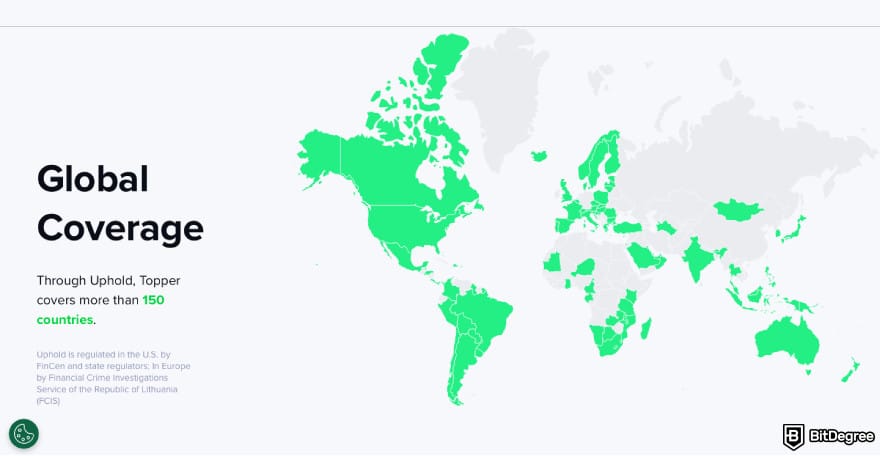
Speaking of geographical variation, Topper could be congratulated for its regional availability. As of writing this, it’s supported in 150+ countries on every continent, including a number of regions that often get the short end of the stick when it comes to the availability of crypto services, such as the US, the UK, and Canada.
Last but not least, Topper has something for the fans of hardware crypto wallets, too. Starting from September 2024, it offers an integration with Ledger Live; a welcome addition, given that Ledger had 14 on-ramps but only 1 off-ramp before Topper joined the list. This gives users more options to sell their crypto for fiat directly on their Ledger Live app.
Limitations
The advantages might look promising enough at first glance, but no platform is perfect! Here are the main shortcomings that knock a few points off Topper's final score:
- Relatively high fees;
- Limited cryptocurrency support;
- Few options for fund recovery.
There’s just no way of going around it: for some users, the benefit of convenience will probably be cancelled out by Topper’s high fees. The most affordable crypto buying method is through a bank transfer, which costs 0.99% of the purchased amount, and all the other methods cost a whopping 3.9%, while the selling fee is 1.75%.
For comparison, Binance and Bybit’s spot trading fees start at just 0.1% for takers and makers.
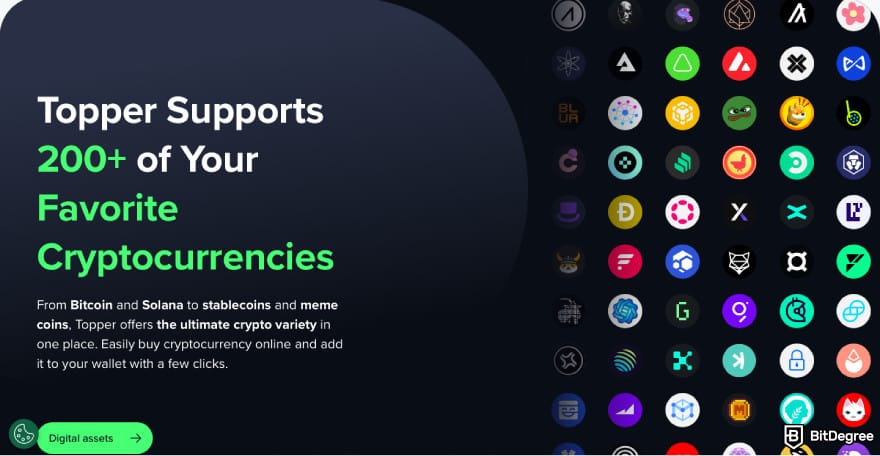
Another limitation you might run into is a relatively limited crypto selection. If you’re only planning to buy or sell major coins, such as BTC, ETH, or SOL, Topper will have you covered, but overall, this service only supports 245 cryptocurrencies, which falls pretty short next to Kraken’s 460+ or Bybit’s impressive list of 2,100+ assets.
Finally, Topper doesn’t offer much in the way of protecting your funds. Since it doesn’t store your crypto but only acts as a transfer service, there’s no way to recover your assets if you sent them to the wrong (but existing) wallet address, for example.
📚 Check Out: Best Cryptocurrency Wallets
Crypto Buying & Selling Features
Now that you have the broad picture of Topper’s strengths and weaknesses, let’s dig deeper into its main features! What is Topper crypto service, exactly, and how does it work?
As I touched on earlier, Topper functions quite differently from centralized crypto exchanges – but, for all intents and purposes, you could think of it as a sort of hybrid crypto-to-fiat swapping service.
It’s similar to DEXs in that it doesn’t store your funds internally and requires having a non-custodial wallet, but, like with CEXs, you'll need to create an account and pass KYC verification.
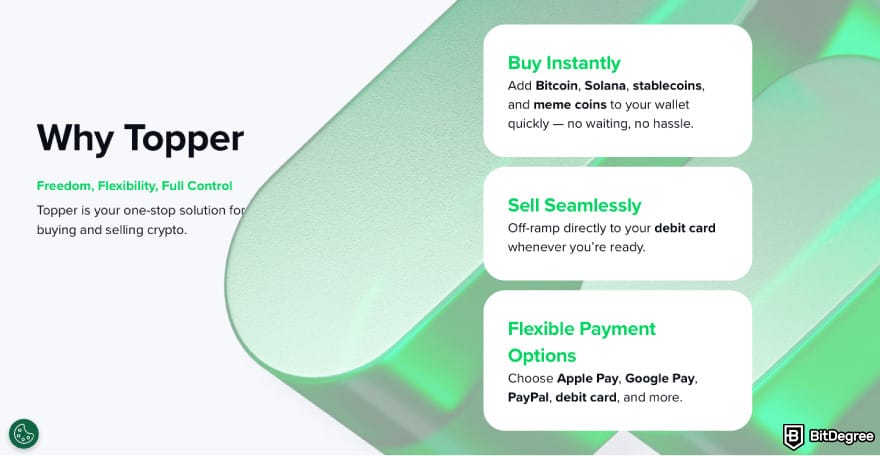
The way Topper works is pretty simple: you can either buy crypto with fiat and send it directly to your non-custodial wallet, or sell your crypto for fiat and withdraw it to your credit or debit card (once you confirm your order, you’ll be asked to enter the wallet address from which Topper will take your crypto and convert it to fiat).
Here are all your options:
- 26 Fiat Currencies. Topper supports the following fiat currencies: EUR, USD, ARS, AUD, BRL, CAD, CZK, DKK, AED, HKD, HUF, INR, ILS, KES, MXN, NZD, NOK, PHP, PLN, GBP, RON, SGD, SEK, CHF, JPY, and CNY.
- 245 Cryptocurrencies. You can buy or sell BTC, ETH, SOL, XRP, USDT, USDC, ADA, ATOM, BNB, DOGE, and other popular altcoins across 37 networks.
- 6 Payment Methods. You can pay for crypto using Apple Pay, Google Pay, PayPal (in the US), Pix (in Brazil), SEPA (in Europe), or your credit/debit card.
All in all, this is a pretty solid list. While some exchanges like Binance and Bybit surpass Topper’s fiat selection for crypto conversion, Topper easily blows most platforms out of the water through its combination of a large list of supported fiat currencies and payment methods.
Fees & Limits
Let’s move on to arguably the most relevant section for most users. Is Topper legitimately worth using, cost-wise?
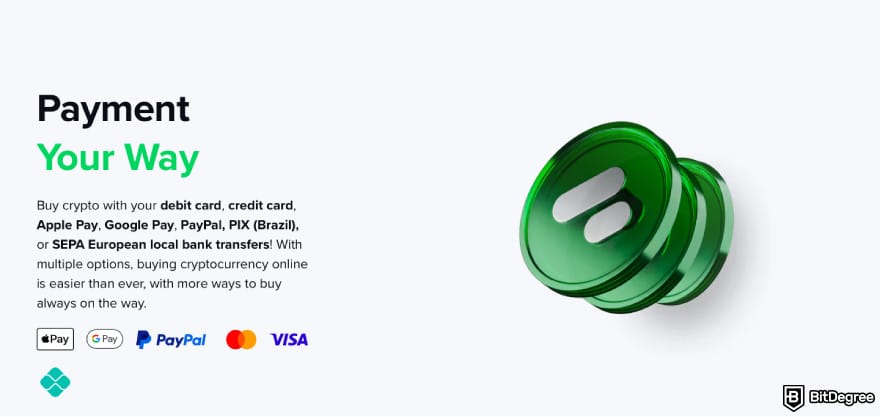
If it were a centralized crypto exchange, I’d begin this chapter by detailing the deposit and withdrawal fees, but let me clear something up first: Topper doesn’t have those, since it doesn’t store your funds, so it’s the buying and selling fees that technically count as deposit and withdrawal fees, respectively.
Here’s what the Topper crypto buying fees look like for each payment method:
Fee | |
|---|---|
SEPA | 0.99% |
Credit/Debit Card | 3.9% |
Apple Pay & Google Pay | 3.9% |
Pix | 3.9% |
PayPal | Payment processing fees |
Table: Topper fees
In comparison, Topper crypto selling fees are much more streamlined, since the only off-ramp (AKA, withdrawal) option is through a debit or credit card. You’ll have to pay 1.75% of the amount you’re selling.
Keep in mind that, aside from the above-mentioned fees, your final order price will also include network fees.
On another note, KYC requirement isn’t the only similarity Topper shares with centralized exchanges; you’ll also have to deal with the following transaction limits:
Debit/Credit Card | Google/Apple Pay | SEPA | Pix | |
|---|---|---|---|---|
Daily | $2,500 | $2,500 | $30,000 | $2,500 |
Weekly | $15,000 | $15,000 | $30,000 | $15,000 |
Monthly | $50,000 | $50,000 | $50,000 | $50,000 |
Table: Topper transaction limits
If you’re a high-volume crypto user and live in Europe, a SEPA bank transfer will probably be your best bet, but once you get to the monthly limits, all the payment methods come out at the same upper ceiling of $50,000.
Security
Is Topper safe? Crypto enthusiasts interested in trying out this platform will no doubt want to learn more about its security measures before diving in further.
As a sidenote, this is another area where Topper diverges from its parent company. As a full-fledged centralized exchange that not only mediates transactions but also stores users' assets, Uphold has a much higher bar for security and features a lot more safeguards, including funds insurance, anti-fraud monitoring, regular third-party audits, and more.
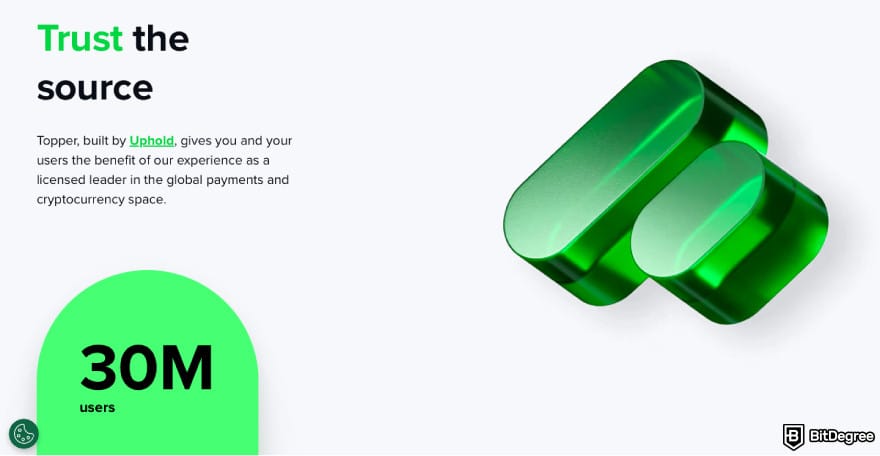
In contrast, Topper only acts as an on-and-off ramp and doesn’t have custody of your funds, which means you’re not in any danger of losing your assets to a cyber attack on its servers, and the security of your crypto or fiat rests entirely on your non-custodial wallet and bank account.
The other side of the coin is that, if something goes wrong, your options are pretty limited.
If your transaction fails because of insufficient funds or some other error, for example, you won’t lose your crypto or money. However, if you accidentally enter an existing wallet address that’s not the one you intended, Topper has no way of letting you undo this transfer and get your assets back.
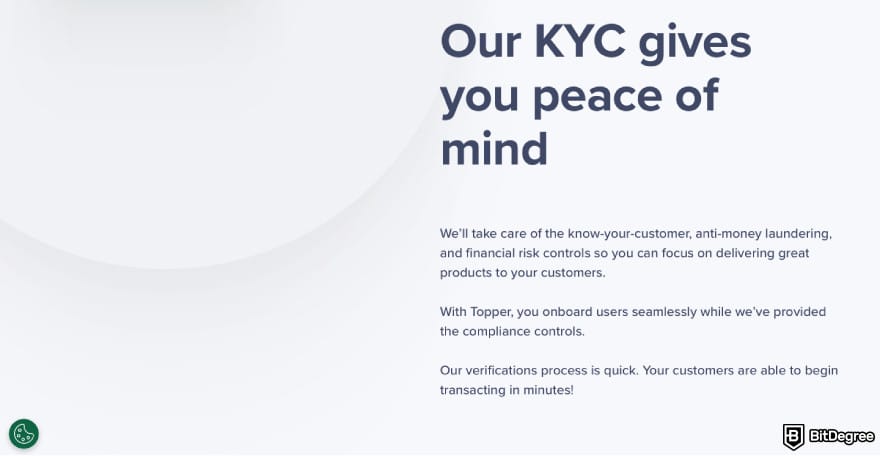
Now, even though KYC verification is typically associated with centralized crypto exchanges, according to the regulations set by the Financial Action Task Force (FATF), it should be required for any crypto platform that involves fiat exchange[1] – which is why Topper makes it mandatory to verify your identity before proceeding with transactions.
Topper crypto KYC requirements boil down to only an upload of a personal ID document and a selfie (though you’ll also have to enter your full residential address and a phone number).
If your Topper account has been inactive for a long time, you might be asked to repeat the KYC verification process and update your personal details.
Aside from KYC, Topper has the following security features:
- 2FA via your connected wallet or email;
- PCI-DSS compliance for card payments;
- Encrypted payment and identity data handling;
- Travel Rule (a regulatory requirement by FATF to collect transaction information for transfers exceeding $3,000 USD or equivalent[2]).
The number one most important thing you can do to use Topper safely is pick a secure self-custodial wallet. It would make a formidable combo with any of the Ledger hardware wallets, for instance - you'd be getting not only top-notch security but a more convenient way to access Topper through the Ledger Live ecosystem, too!
📚 Related: Crypto Security Guide
Localization & Regional Adaptability
Geographical restrictions are a bane of many crypto enthusiasts: there’s nothing worse than finding your perfect platform, only to discover you’re not allowed to use it. This is where Topper definitely comes out ahead, though.
It’s supported in more than 150 countries worldwide, including the US (except for some of its states and overseas territories), Canada, and the United Kingdom.
Here’s the full list of all countries and regions where Topper isn’t available:
Countries | |
|---|---|
Africa | Algeria, Angola, Benin, Burkina Faso, Burundi, Central African Republic, Chad, Congo (Democratic Republic), Congo (Republic), Côte d'Ivoire, Egypt, Equatorial Guinea, Eritrea, Ethiopia, Guinea, Guinea-Bissau, Liberia, Libya, Mali, Mauritius, Morocco, Nigeria, Somalia, Sudan, Tanzania, United Republic of Togo, Tunisia, Uganda, Zimbabwe |
Asia | Afghanistan, Armenia, Azerbaijan, Bangladesh, Cambodia, China, Georgia, Iran, Iraq, Jordan, Kazakhstan, Lebanon, Mongolia, Myanmar, Nepal, North Korea, Pakistan, Russian Federation, Sri Lanka, Syria, Turkmenistan, Uzbekistan, Yemen |
Europe | Albania, Belarus, Bosnia and Herzegovina, Crimea, Germany, Gibraltar, Kosovo, Moldova, Montenegro, Netherlands, Serbia, Ukraine |
North America | New York (US), Anguilla, Aruba, Barbados, Cuba, Jamaica, Haiti, Trinidad and Tobago, Virgin Islands (US) |
Central & South America | Ecuador, Nicaragua, Venezuela |
Oceania | American Samoa, Fiji, Palau, Samoa, Vanuatu |
Table: Topper-restricted countries
Another thing to keep in mind is that the payment methods on Topper are also subject to some regional restrictions. For example, while credit/debit cards, Apple Pay, and Google Pay are available in all supported countries, PayPal, Pix, and SEPA are only available to residents of the US, Brazil, and Europe, respectively.
User Experience
Now that I’ve answered questions like, “What is Topper for?” and “Is Topper safe?”, crypto enthusiasts like you will probably want to get the lowdown on what using this platform is actually like.
If there’s one thing that Topper has going for it, it’s an intuitive user experience. As soon as the website loads, you’ll be greeted with the on-and-off-ramp panel. On Topper, “Buy Crypto” and “Sell Crypto” are the only options, with no other trading types or services to get in the way.
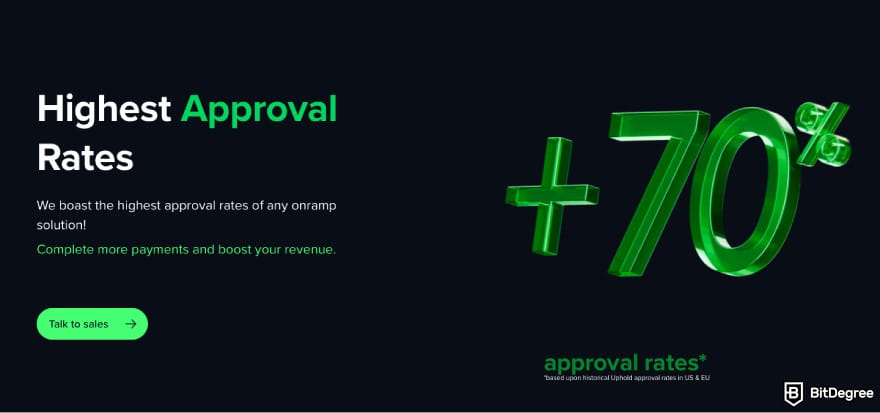
A minimalist interface is all well and good, you might say – but how long does a Topper crypto order take? The good news is that, unlike with Limit Orders on spot trading platforms, you won’t have to sit and wait for your order to come through.
With most methods of payment, you’ll get your crypto immediately or within a few minutes (although a SEPA transfer might take up to 3 business days).
When you place an order, Topper will automatically send you an email with a link to your order details page, where you can check the status of your transaction and track its progress.
You can also download your entire transaction history by going to the Preferences center > Transaction history and clicking [Generate report].
Topper doesn’t offer much in the way of customization, but you’ll still find a few settings, such as changing the interface language (American English, Brazilian Portuguese, or Spanish), managing email notifications and cookie preferences, or adding new payment methods.
Unfortunately, there’s no way to update personal details, except during periodic KYC verification renewals.
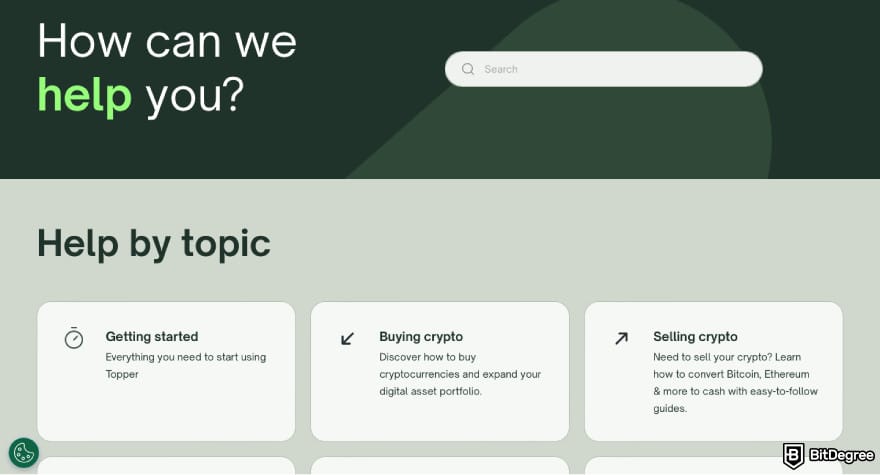
This platform doesn’t have a dedicated mobile app, but it’s safe to say it doesn’t really need one: its interface panel is fully optimized for the small screen and, if anything, looks even better on a smartphone!
For customer support, Topper features a knowledge base that’s a bit basic but still sufficient for finding an answer to most of the common issues and use cases. There’s no live chat, but you can fill out a support request ticket directly on the website.
It's worth mentioning that Topper has a 4.0 rating on TrustPilot, and the company has replied to 92% of the negative Topper crypto reviews.
How to Use Topper
Even though Topper is owned by Uphold, you’ll have to create a separate account to use it. The process might feel a bit cumbersome, as you can only sign up while already trying to complete a transaction, and the KYC verification is built in, but don’t worry – it’s still pretty easy and straightforward. Here’s how to do it:
![Topper crypto review: click [Buy or Sell Crypto]. Topper crypto review: click [Buy or Sell Crypto].](https://assets.bitdegree.org/images/topper-crypto-review-homepage.jpg)
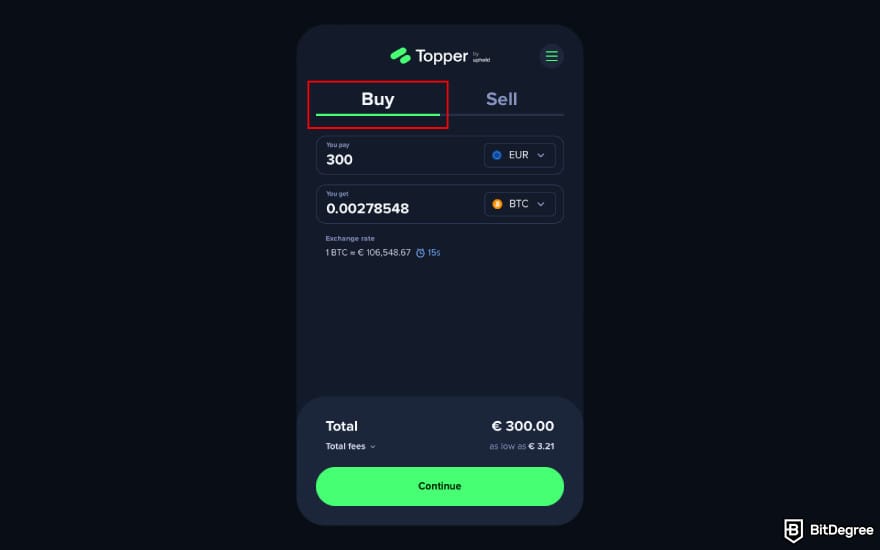
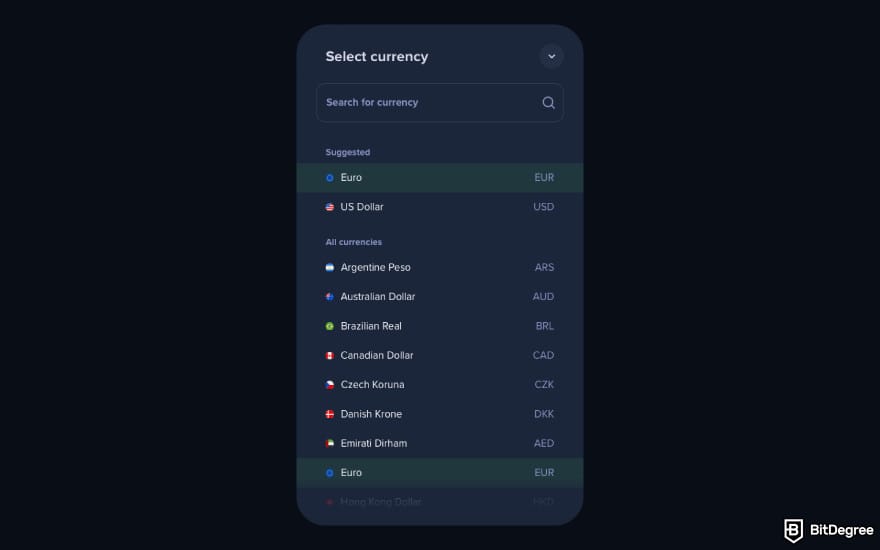
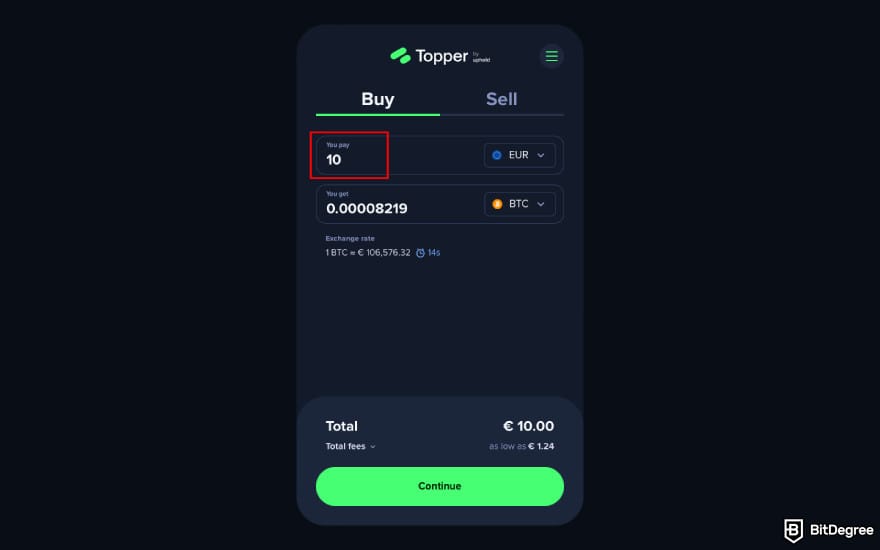
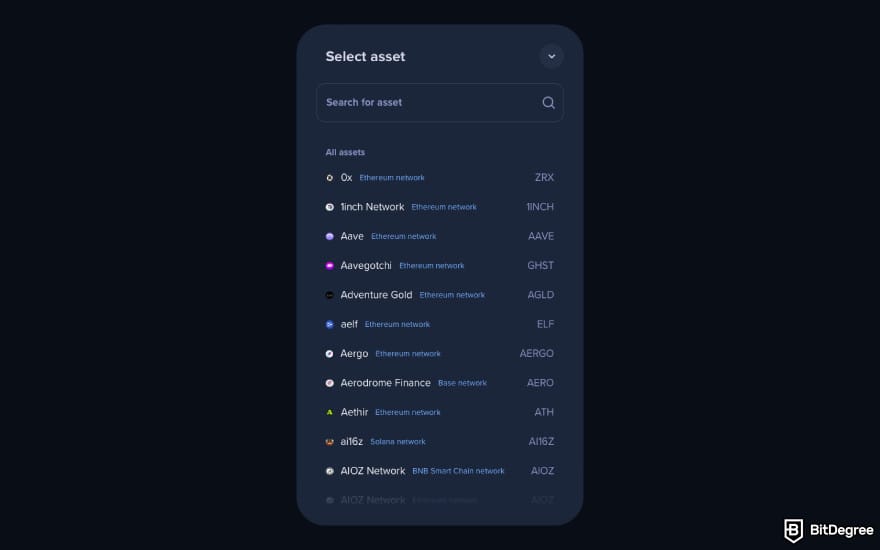
![Topper crypto review: click [Continue]. Topper crypto review: click [Continue].](https://assets.bitdegree.org/images/topper-crypto-review-continue.jpg)
![Topper crypto review: click [Request verification code]. Topper crypto review: click [Request verification code].](https://assets.bitdegree.org/images/topper-crypto-review-request-verification-code.jpg)
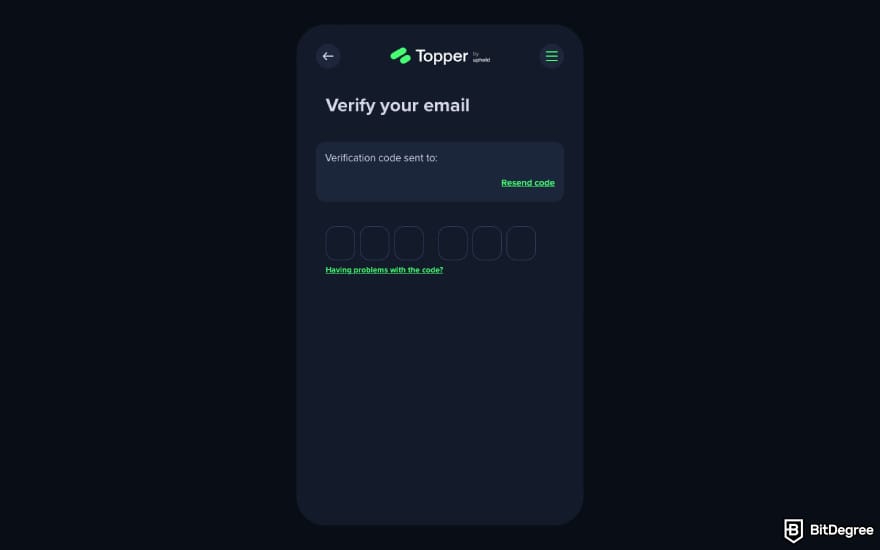
![Topper crypto review: click [Submit personal details]. Topper crypto review: click [Submit personal details].](https://assets.bitdegree.org/images/topper-crypto-review-submit-personal-details.jpg)
![Topper crypto review: click [Continue] after completing KYC on your phone. Topper crypto review: click [Continue] after completing KYC on your phone.](https://assets.bitdegree.org/images/topper-crypto-review-continue-after-kyc.jpg)
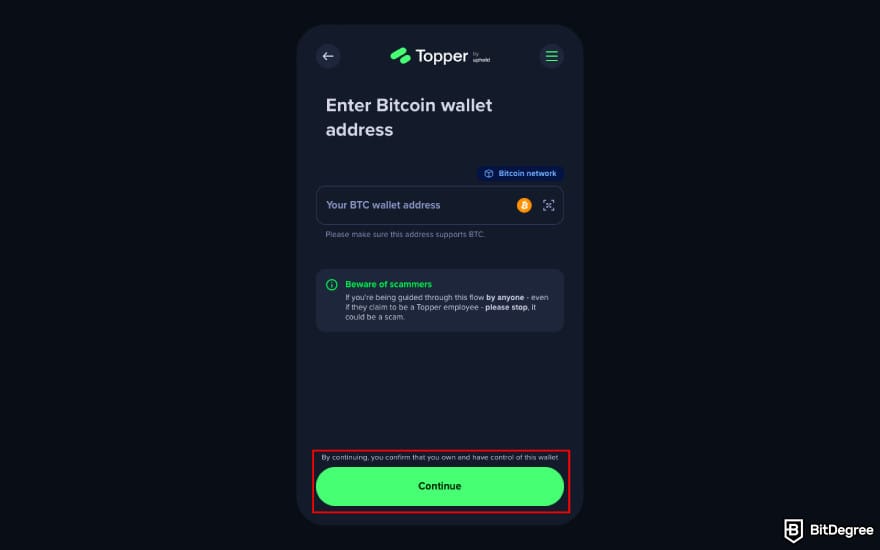
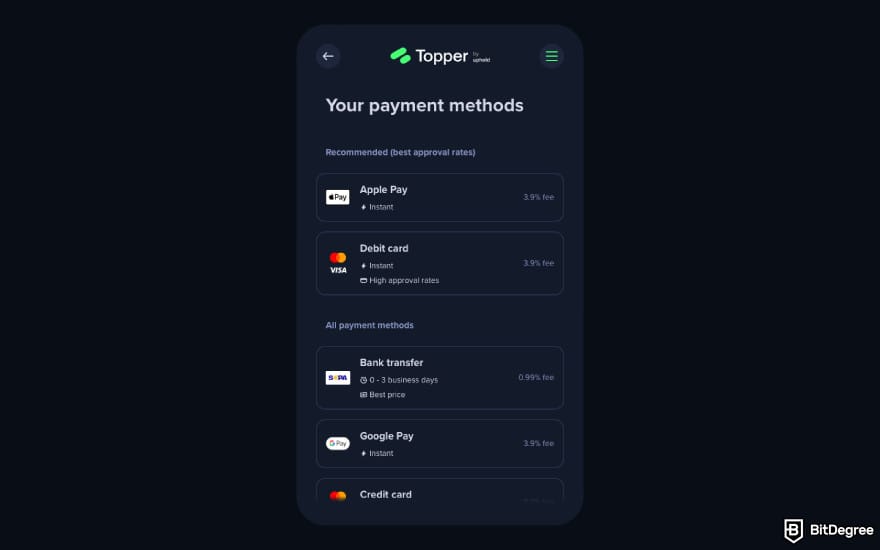
![Topper crypto review: click [Review order]. Topper crypto review: click [Review order].](https://assets.bitdegree.org/images/topper-crypto-review-review-order.jpg)
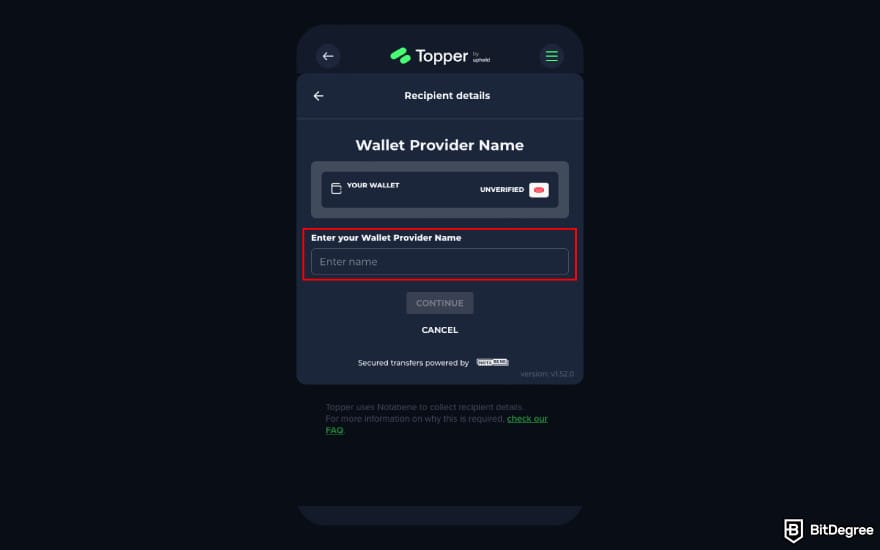
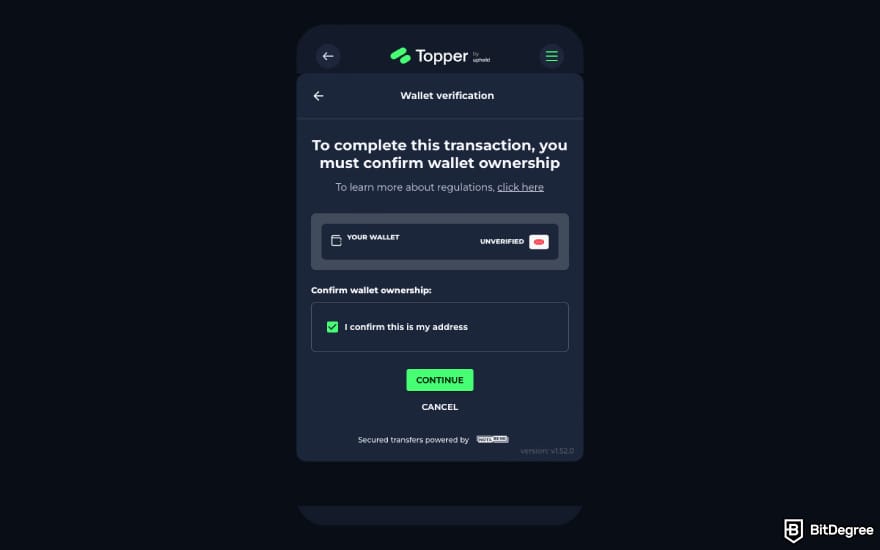
Here you go! Like I said, the crypto you just bought will drop straight into your non-custodial wallet, with no middleman necessary. And don't worry, while step-wise, the process seems pretty long, it actually goes by quickly.
Comparison to Other Popular Alternatives
That’s all you need to know about this platform – time to take my Topper crypto review to the next level by exploring how it stacks up against its alternatives. For many crypto users, centralized exchanges are still the go-to option for all their crypto needs.
With that in mind, here are the top players worth checking out if you're looking for a more powerful platform with a Swiss army knife's worth of crypto trading solutions.
Topper VS Binance
With over 283 million users worldwide, Binance is currently the biggest and most popular centralized crypto exchange in the world. It offers 500+ cryptocurrencies across 1,500+ market pairs and a whole arsenal of trading types for both beginners and pros: options, futures, margin, copy trading, and even a P2P marketplace.
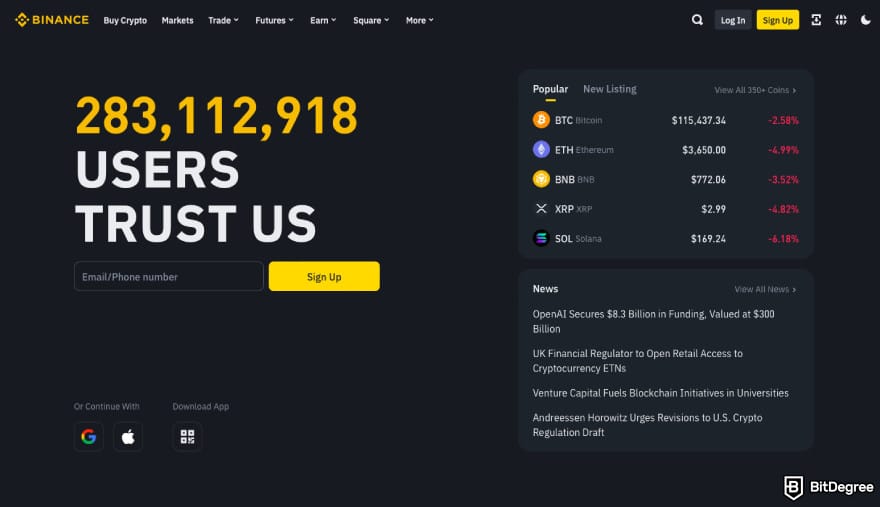
If you’re looking to buy or sell crypto for fiat instantly, Binance’s other trading types won’t necessarily be relevant to you, but its instant purchase option should easily cover most of your needs. Binance offers a staggering 115+ fiat currencies to choose from, dwarfing Topper’s much more modest list of 26 fiat currencies.
Binance claims to support credit and debit cards from over 220 countries, which puts it on par with Topper when it comes to regional coverage (except it's not available in the US like Topper is).
However, it comes out ahead with payment methods: you can purchase crypto with a credit/debit card, SEPA, PayPal, Apple Pay, Google Pay, Skrill, and Neteller. What’s more, Binance integrates with a few other payment services like Revolut Pay and Paymonade, depending on your region.
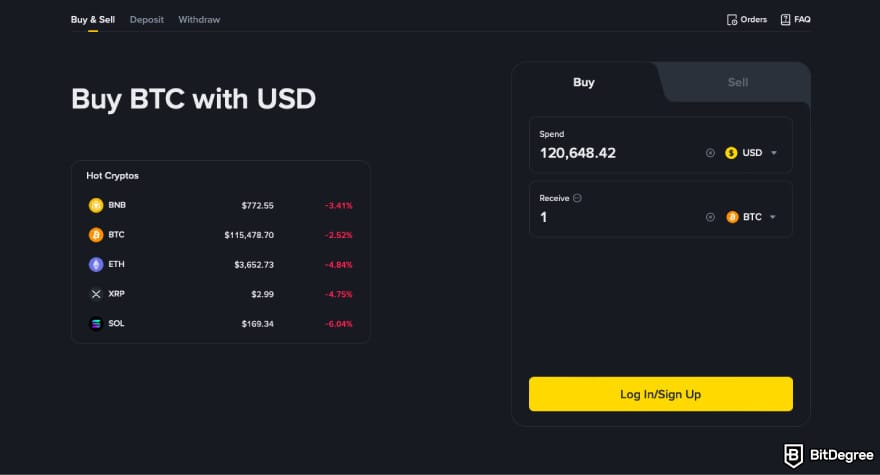
Binance deposit, withdrawal, and buying/selling fees depend on the asset and method of payment. Some of these fees are flat and fixed, while others are a percentage rate. For example, SEPA deposits cost 0.3 EUR, while credit/debit card payment, Apple Pay, and Google Pay transfers have a 2% fee, which is almost twice as low as Topper fees.
As a major centralized exchange with tons of additional services, Binance can definitely feel a bit bloated next to Topper, though. If you’re looking for a more user-friendly experience, the mobile app with its Lite interface option will probably be your best bet, but overall, Topper is still the winner in the user experience department.
📚 Check Out: Binance Review
Topper VS Kraken
Kraken has 15+ million users across 190+ countries. You’ll find ~420 cryptocurrencies and a variety of trading options like margin trading with up to 5x leverage, derivatives trading with 200+ multi-collateral contracts, a DeFi swapping platform, and an OTC trading desk.
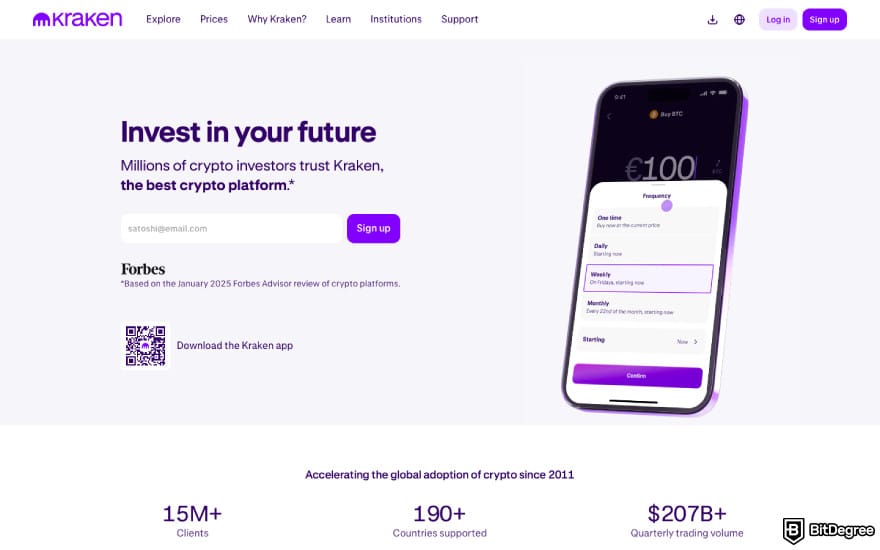
Unfortunately, Kraken offers a much more limited fiat currency selection for instant crypto purchases. You can choose between 7 currencies: USD, EUR, CAD, GBP, CHF, AUD, and JPY. Kraken’s payment methods are, for the most part, the same ones you’ll find on Topper, with the exception of Pix.
Kraken is available in 190+ countries, including the US (but not for residents of Maine, New York, and Washington). Still, its limited fiat availability makes it inaccessible or, at least, less convenient for most users around the world who don’t use one of the 7 available fiat currencies.
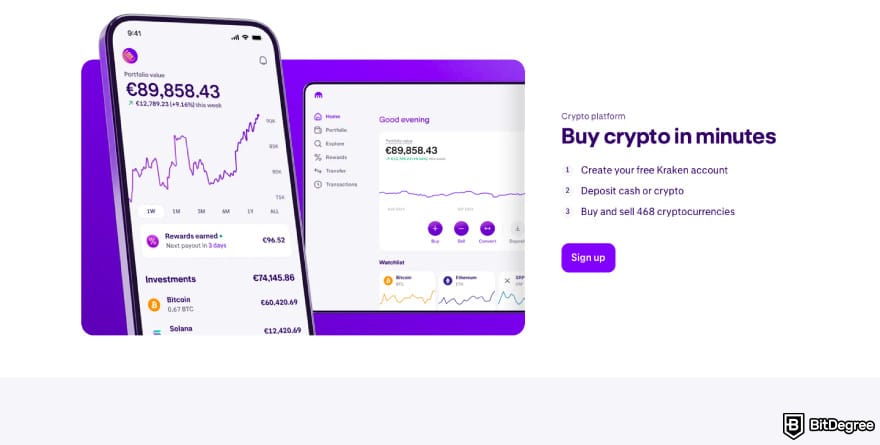
As for the fees, Kraken charges a 1% rate for selling and buying crypto (which is much lower than Topper fees for all payment methods except for the SEPA transfer). If you’re buying with a credit/debit card, there will be an additional payment processing fee. Fiat deposit and withdrawal fees vary depending on the currency and payment method.
Unlike Topper, Kraken automatically selects the fiat currency according to your location, and there’s no option to switch to another one. This might feel a bit limiting, but on the other hand, it makes the process a bit more streamlined.
If you’re looking to use Kraken to buy or sell crypto with fiat, you’ll probably prefer its mobile app, where this feature is a lot more front and center and easily accessible with just a couple of clicks.
📚 Check Out: Kraken Review
Topper VS Bybit
Launched in 2018, Bybit has made a name for itself in the crypto exchange scene as one of the best platforms for crypto selection and competitive trading fees. It has more than 60 million active users. You’ll find almost 2,000 cryptocurrencies and a considerable selection of trading options, such as margin, futures, options, spread trading, and pre-market trading.
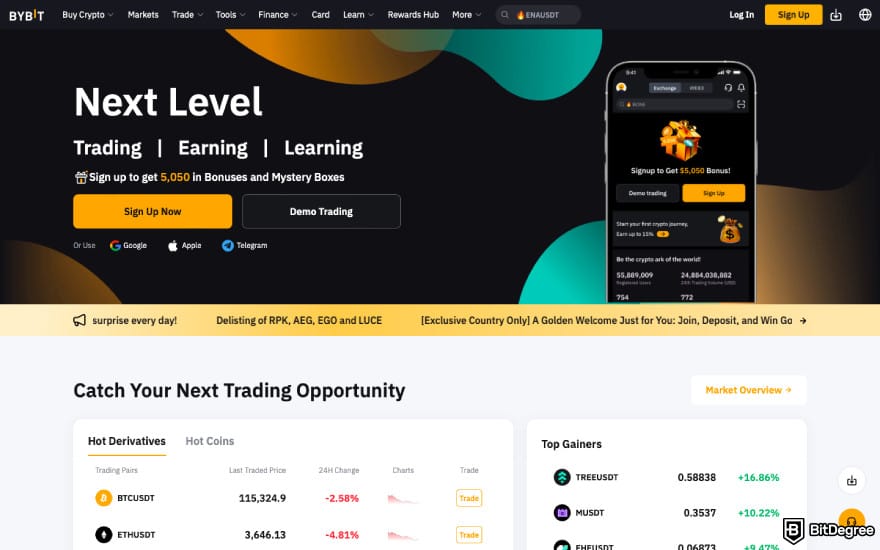
Bybit’s fiat-to-crypto options are a bit less convenient: to buy crypto with fiat, you’ll first need to deposit some fiat into your account. Bybit goes head-to-head with Topper with its list of 24 supported fiat currencies. Its payment methods include credit/debit card, Apple Pay, Google Pay, and SEPA; again, not too different from Topper here. Most users will have no issue finding their preferred option.
This exchange is available in 160+ countries, many of which overlap with Topper’s regional coverage, but some countries are left out: residents of the US, Canada, France, and the United Kingdom won’t be able to access Bybit.
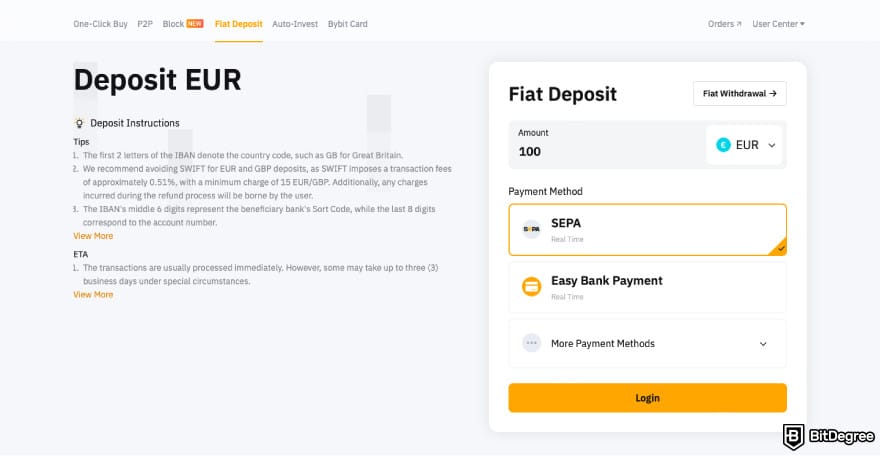
Bybit’s instant crypto buying/selling fees range from 0.5% to 3.5%, depending on the fiat currency and the payment method, which comes out to quite a broad spectrum, but still mostly within the same league as Topper. On the other hand, Bybit’s spot trading fee of 0.1% for both takers and makers takes the crown as the most affordable way to buy crypto on this platform.
Bybit’s web or mobile app doesn’t offer a Lite interface option, so if you’re just trying to instantly buy or sell some crypto, I'd recommend sticking with Topper, but aside from that and the potential hassle of having to fund your account balance with fiat first, its user experience feels intuitive enough for an exchange with such a wealth of features.
📚 Check Out: Bybit Review
Topper VS Uphold
It would be hard to imagine this Topper crypto review without a rundown on how this on/off-ramp service measures up to its parent platform. Launched in 2013, Uphold is one of the oldest crypto exchanges out there, serving over 10 million users, and offers a way to buy not only crypto but also fiat currencies and precious metals like platinum, palladium, and silver.

Uphold supports 27 fiat currencies, and what's more, you can exchange one fiat currency for another. You'll have plenty of payment methods to choose from, as well: debit/credit card, Apple Pay, Google Pay, SEPA, ACH, or FPS, depending on your country of residence.
Speaking of geographical coverage, you might be surprised to hear that Uphold's list of supported countries isn't completely identical to Topper's, even though the latter is owned by Uphold. While for the most part, the two lists overlap, users who live in Germany, the Netherlands, Georgia, Moldova, and Mauritius have access to Uphold but not Topper.
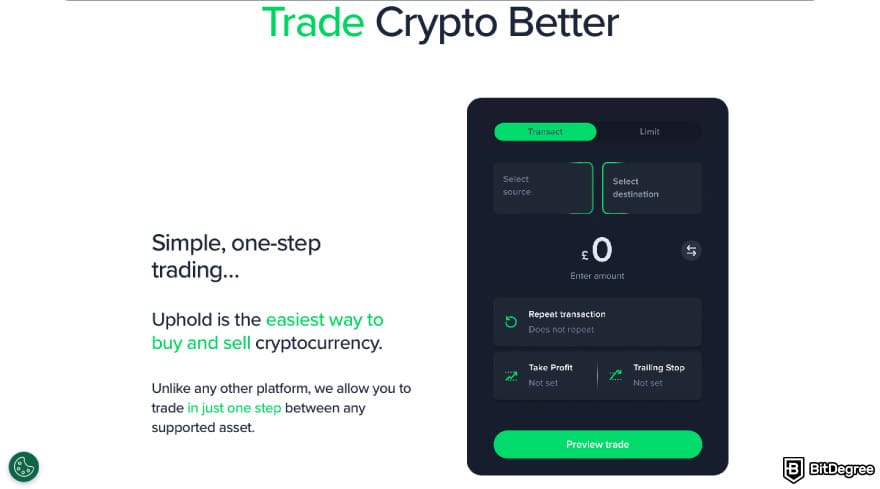
Unlike most other centralized exchanges, Uphold doesn't subscribe to your typical maker-taker fee structure: instead, its trading fees are categorized by asset type. The fee for fiat currency exchange is 0.3%, while fiat deposit and withdrawal fees are the same as on Topper (except for SEPA withdrawals, which are free).
When it comes to user experience, transitioning from Uphold to Topper or the other way around should feel pretty seamless; the only major difference is that Topper doesn't have a dedicated mobile app. The two platforms share the same market access and liquidity. That said, you'll still need to create a separate account to use Uphold and pass its KYC.
📚 Check Out: Uphold Review
Conclusions: Is Topper Right for You?
Time to wrap up this Topper crypto review with a quick recap! This fiat on-ramp stands out as a two-way service that allows users to both buy crypto with fiat using a number of available payment methods and send it off to their credit or debit card, all in one platform.
While Topper offers a convenient crypto-to-fiat bridge for DeFi users who don't need a centralized crypto exchange, it's not without a catch. Its buying and selling fees are quite high compared to what you'd find on most exchanges, and the cryptocurrency selection is a bit on the smaller side, too.
The content published on this website is not aimed to give any kind of financial, investment, trading, or any other form of advice. BitDegree.org does not endorse or suggest you to buy, sell or hold any kind of cryptocurrency. Before making financial investment decisions, do consult your financial advisor.
Scientific References
1. Chen Y., Gurrola-Perez P., Lin K.: 'A review of crypto-trading infrastructure';
2. Pocher N.: 'Traceability of crypto-asset transfers under the new EU AML/CFT regime: the crypto travel rule between challenges and open issues'.
